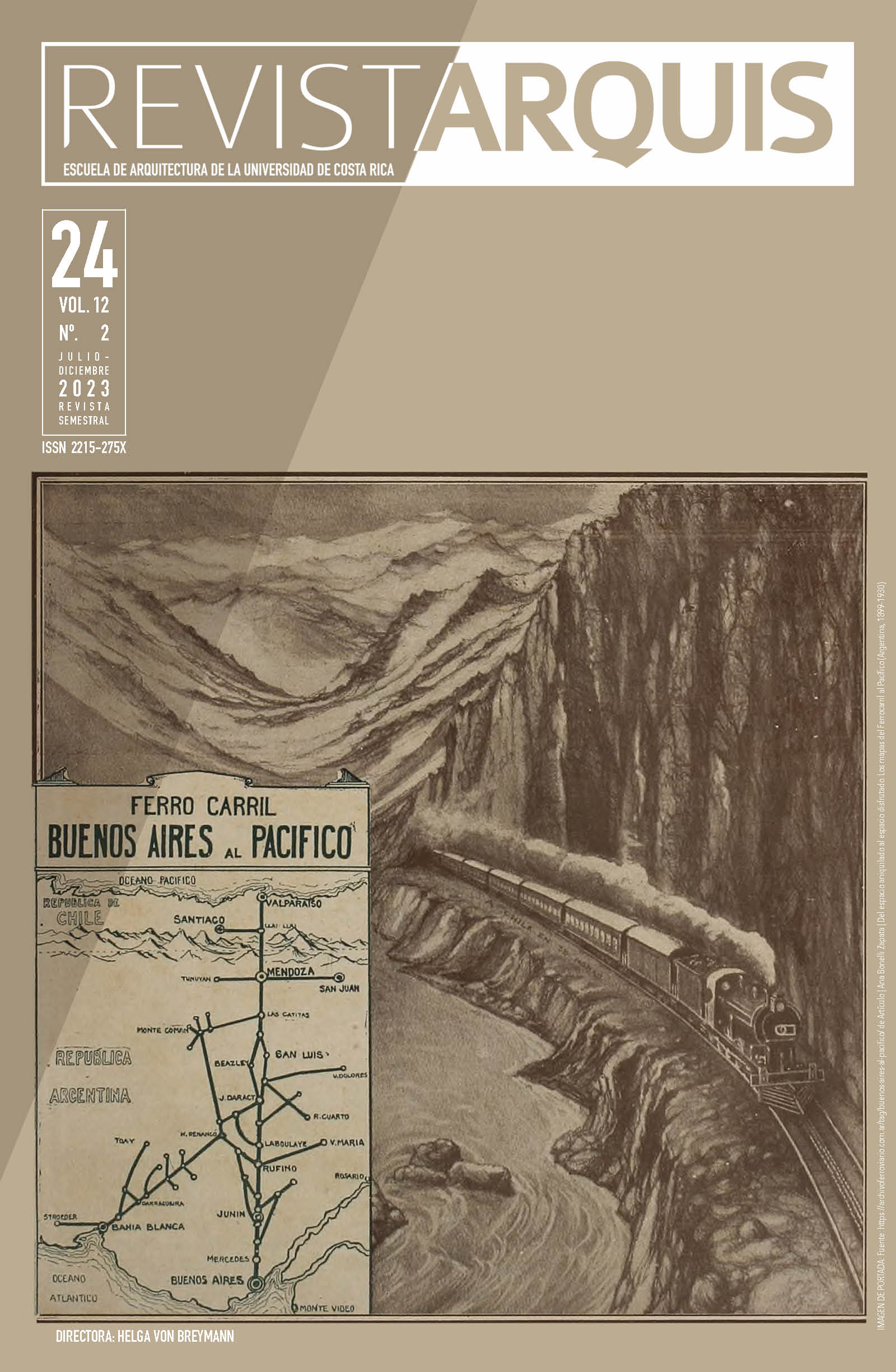Abstract
The biopolitical approach here presented, aims to interpret the morphological and programmatic characteristics of the residential complex of the Central Factory of Milk, considering the conceptualizations provided by M. Foucault on the notion of population and environment with the treatment of its vital processes for an economic availability of its productive forces. Located in the first industrial periphery of the city of Santiago, the Central Factory of Milk’s complex, is a residential group adjacent to the homonymous dairy factory. The complex also had community facilities, commerce, and a health clinic, which in its arrangement are seen as a unit, arranging daily life and its safeguards in terms of production. This residential and industrial complex has its origins in the management of the Workers’ Insurance Fund, the first Chilean and Latin American initiative for provision of health, sickness, and elderly workers' welfare, through contributions from employers, the State, and the hired workers. This institution articulated early on the healthiness of its members from the perspective of social medicine, taking care of the sanitary equipment for health care and welfare, but also planning the residential space and work conditions to strengthen their productive forces. This care for the workforce is understood here from a biopolitical perspective, recognizing the regulation and assurance strategies that, through a qualitative and relational methodology on specific documents, will be associated with architectural and urban aspects of residential, health, and productive programs of the residential complex of Central Factory of Milk.
References
Ahumada, D. (2018) El proceso de formulación de la Ley de la Caja del Seguro Obrero Obligatorio de 1924. Revista Notas Históricas y Geográficas, 21, 89-121. https://www.revistanotashistoricasygeograficas.cl/index.php/nhyg/article/view/236
Antonelli, M. (2015). Gilles Deleuze y el debate biopolítico contemporáneo. Revista de Filosofía y Teoría Política (46). En Memoria Académica. Disponible en: http://www.memoria.fahce.unlp.edu.ar/art_revistas/pr.6867/pr.6867.pdf
Agamben, G. (2011). ¿Qué es un dispositivo?. Sociológica (México), 26(73), 249-264. Recuperado en 20 de septiembre de 2022, de http://www.scielo.org.mx/scielo.php?script=sci_arttext&pid=S0187-01732011000200010&lng=es&tlng=es.
Biondi, A. (1946). Función y responsabilidad del médico en la seguridad social. En Problemas importantes de Medicina Social en el Seguro Obrero Chileno. Primer Congreso médico - social Panamericano, La Habana, 3-8 de diciembre de 1946. Santiago de Chile: Talleres gráficos “La Nación” S.A.
Caja del Seguro Obligatorio. (1944) Desarrollo estructural y funcional. Racionalización de los servicios y prestaciones. Dirección de los Servicios Médicos. Santiago. Imprenta Gutenberg.
Campos, A. Basáez, P. (2014) Red de Consultorios de la Caja del Seguro Obrero Obligatorio en Santiago. Un Patrimonio Emblemático. Santiago, LOM Ediciones.
Campos, A., Harris, R., González-E, D. (2022). Una lectura biopolítica de la arquitectura del Seguro Obrero. Colectivos residenciales en Arica e Iquique. Revista De Arquitectura (Bogotá), 24(1), 44–53. https://doi.org/10.14718/RevArq.2022.2452
Carmona N. (2008). Central de Leche "Chile": un caso de industrialización estatal fallido. (1935-1960). https://repositorio.uchile.cl/handle/2250/110520
Consejo de la Caja del Seguro Obligatorio, (1935). Las actividades de la Caja del Seguro Obligatorio en los dos últimos años. Santiago. Imp. Lers.
Foucault, M. (1974). Historia de la Medicalización. Organización Panamericana de la Salud (1977). Educación médica y salud. 11(1), 3-25.
Foucault, M. (1996). Genealogía del racismo. Cap. 11 Del poder de soberanía al poder sobre la vida. La Plata. Altamira.
Foucault, M. (2000). Los anormales. Fondo de Cultura Económica, Buenos Aires, Argentina.
Foucault, M. (2003). Vigilar y Castigar. Nacimiento de la prisión. Buenos Aires. Siglo XXI editores.
Foucault, M. (2006). Seguridad, territorio, población. Curso en el Collège de France: 1977-1978, Buenos Aires, Fondo de Cultura Económica.
Guerrero, J. (2009). El Edificio de la ex Fábrica Central de Leche Santiago: Un paradójico caso de Patrimonio Arquitectónico Industrial Reconvertido en riesgo de desaparición. Seminario de Investigación. Instituto de Historia y Patrimonio. Facultad de Arquitectura y Urbanismo Universidad de Chile.
Ibarra, M. Bonomo, H. (2012) De la fábrica a la vivienda. La protección de la memoria obrera en torno a la Fábrica Central de Leche. Santiago de Chile. APUNTES, 25, (1). 50-6. https://revistas.javeriana.edu.co/index.php/revApuntesArq/article/view/8832
Illanes., M. (2010) En el nombre del pueblo, del estado y de la ciencia. Historia social de la salud pública, Chile 1880-1973: hacia una historia social del siglo XX. Santiago de Chile. Ministerio de Salud. Protege Red de Protección Social, Gobierno de Chile.
Labbé, V. (1946). La medicina del trabajo en Chile. En Problemas importantes de Medicina Social en el Seguro Obrero Chileno. Primer Congreso médico - social Panamericano, La Habana, 3-8 de diciembre de 1946. Santiago de Chile. Talleres gráficos “La Nación” S.A.
Plaza, P. (2011). De Bentham a Le Corbusier: Vigilancia y disciplina en la vivienda social moderna latinoamericana. El Complejo habitacional Pedregulho, Río de Janeiro, Brasil (1947-1958). Atenea (Concepción), (504), 111-130. https://dx.doi.org/10.4067/S0718-04622011000200007
Quintanas, A. (2011). Higienismo y medicina social: poderes de normalización y formas de sujeción de las clases populares. Isegoría, 0(44), 273-284. https://dx.doi.org/10.3989/isegoria.2011.i44.730
Rojas, L., Carvajal, M., Ortega, A. (2015). Entre rieles y chimeneas. Andros. Santiago de Chile.
Saidel, M. (2013). Lecturas de la biopolítica: Foucault, Agamben, Esposito. Opción, 177, 88-107. Recuperado de https://ri.conicet.gov.ar/handle/11336/6430
Solano, E. (2016). En busca de sentido simbólico en el diseño arquitectónico. Reapropiación de la investigación cualitativa con una perspectiva abductiva. Legado De Arquitectura y Diseño, 11(19), 59-66. https://legadodearquitecturaydiseno.uaemex.mx/article/view/14949
Urabayen, J., & León Casero, J. (2018). Espacio, poder y gubernamentalidad. Arquitectura y urbanismo en la obra de Foucault. Anales del Instituto de Investigaciones Estéticas, 1(112), 181-212. https://doi.org/10.22201/iie.18703062e.2018.112.2634
##plugins.facebook.comentarios##

This work is licensed under a Creative Commons Attribution-NonCommercial-NoDerivatives 4.0 International License.
Copyright (c) 2023 Alicia Campos Gajardo

